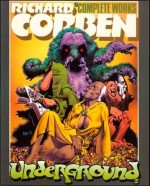
By Richard Corben and various (Catalan Communications)
ISBN: 978-0-87416-026-X
Although never a regular contributor to the comicbook mainstream, animator, illustrator, publisher and cartoonist Richard Corben is one of America’s greatest living proponents of sequential narrative: an astoundingly accomplished artist and unique, uncompromising auteur with an unmistakable style and vision.
Corben flowered in the independent counterculture commix of the 1960s and 1970s to become a globally revered, multi-award winning creator. He is most renowned for his mastery of the airbrush and his delight in sardonic, darkly comedic horror, fantasy and science fiction tales.
Born in Anderson, Missouri in 1940, he graduated with a Fine Arts degree in 1965 from the Kansas City Art Institute and began working as an animator. At that time, the Underground movement was just stating to revolutionise, reinvigorate and liberate the medium of comics as a motley crew of independent-minded creators across the continent began making and publishing stories that appealed to their rebellious, pharmacologically-enhanced sensibilities and unconventional lifestyles.
Most of them had been reared on and hugely influenced by 1950s EC Comics or Carl Barks’ Duck tales – and usually both.
Corben started the same way, producing the kind of stories that he would like to read, in as variety of small-press publications including Grim Wit, Slow Death, Skull, Fever Dreams and his own Fantagor often signed with his affectionate pseudonym “Goreâ€. As his style matured and his skills developed Corben’s work increasingly began to appear in more professionally produced venues. He began working for Warren Publishing in 1970 with tales in Eerie, Creepy, Vampirella, Comix International and latterly, the aggressively audacious adult science fiction anthology 1984. He also famously re-coloured a number of reprinted Spirit strips for the revival of Will Eisner’s the Spirit magazine.
In 1975 Corben submitted work to the French fantasy phenomenon Métal Hurlant and subsequently became a fixture in the magazine’s American iteration Heavy Metal after which his career really took off. Soon he was producing stunning graphic escapades for a number of companies, making animated movies, painting film posters and producing record covers such as the multi-million-selling Meatloaf album Bat Out of Hell. He never stopped making comics but preferred his own independent projects with collaborators such as Harlan Ellison, Bruce Jones and Jan Strnad.
This regrettably out-of-print collection is the second of three collecting his early strip efforts, mostly taken from Fantagor, offering a unique insight into his burgeoning mastery and displaying more powerful, wickedly whimsical and sardonic suspense tales in the EC vein. The first few are in black and white beginning with ‘Inna Pit’ a post apocalyptic comi-tragedy followed by an anti-capitalist eco-fable entitled ‘Dumb Story’
‘Razar the Unhero’ (written by “Starr Armitage†in 1970) is a dark and sexily violent spoof of Sword and Sorcery epics with a deprecating edge whilst Herb Arnold signed his real name to his script for ‘Chard’: a far more straightforward barbarian adventure saga. ‘The Story of Otog’, based on an ancient Japanese folk tale and adapted by Corben and Harvey Sea, is an impressive and moving early taste of more ambitious things to come…
Obnoxious, smug Razar was far too enjoyable a character to abandon and he returned in all his mendacious glory in ‘Necromancer’, a far less jolly romp and the last monochrome tale contained here whereas the Jan Strnad penned ‘To Spear a Fair Maiden’ returned to outrageous tomfoolery, bloody violence and Frat-Boy crassness as the itinerant warrior was hired by a desperate father to save the world by deflowering his daughter before a wizard can turn her valuable virginity into a deadly spell. Of course things do not go as planned…
‘The Secret of Zokma’ is a truly grim and horrific tale of exploration and contamination balanced by the grotesque and hilarious parable of backwoods infidelity ‘Lame Lem’s Love’ and this volume concludes with ‘The Temple’ – a whimsical and vituperative reinterpretation of the Garden of Eden myth with a sting in the tail…
Corben’s infamous signature-stylisation always includes oodles of nudity, extreme and graphic violence and impossibly proportioned male and female physiques, and there’s plenty of all included here. His groundbreaking work reshaped our art-form and the fact that so much of his canon is currently unavailable in English is a crime. Not only are these early works long overdue for a definitive re-issue but all his rude, riotous, raucously ribald revels need to be re-released now…
© 1970, 1971, 1972, 1973, 1986 Richard Corben. © 1986 Catalan Communications. All rights reserved.
